How to Measure Employee Engagement ROI: 14 Key Metrics to Track
Discover how to measure employee engagement the right way. Explore key employee engagement metrics, ROI formulas, and a step-by-step process to evaluate and refine your engagement strategy for maximum impact.
On this page
With human capital being the most essential element in any organization, employee engagement continues to take center stage for HR leaders. But to make real progress, it’s not just about running engagement activities—it’s about using the right employee engagement metrics and tracking the ROI of employee engagement to validate their impact.
From MBOs and personal goal setting in the early 60s to today's data-driven HR systems, the function has come a long way in proving its business value. For employee engagement to move from a “nice-to-have” to a measurable business initiative, organizations must prioritize how to measure employee engagement in a way that aligns with strategic goals.
When done right, the returns are hard to ignore. Engaged organizations see an 81% drop in absenteeism and a 14% boost in productivity.
So, what’s still missing?
Despite multiple efforts, many companies still fall short. Research by Aberdeen shows that organizations with high engagement levels outperform those with low engagement by over 200%.
Here’s the truth: a strong engagement program is an investment, and like any investment, it needs a clear path to return. This blog breaks down how to measure employee engagement, choose the right employee engagement metrics, and design programs that show the ROI of employee engagement—all with accountability and business alignment in mind.
Gather valuable insights through customizable surveys that are simple to distribute and foster a positive and engaging corporate culture using Leapsome.
👉 Schedule a demonstration today!
Best practices while measuring employee engagement program success
Business owners will want to see its impact if you're running an engagement program. They expect HR teams to demonstrate how it contributes to performance and ROI. Data replication tools help consolidate and analyze employee data, making it easier to measure program success.
With advanced tech, tracking ROI on recognition, rewards, and incentives is now possible. Given today’s challenges—like talent shortages and shifting workforce dynamics—it's time to rethink your strategy. Here are 11 best practices to improve your engagement program.
1. Define your program goals
First, if your staff doesn't understand your organization or team's overall goals, incentivizing them is useless.
Ask your team members: Do you understand our company's vision? Do you know your specific objectives and goals?
Even if they have an idea, it's always wise to brush up on goals before starting or revamping your rewards program.
Start from the top, delineate your corporate mission, move on to specific department's objectives. Finish with the team and individual goals. By outlining the company's mission and how that trickles down to each employee, your staff will understand the impact of their work.
2. Set up some focus groups
If you think that a few 'yes/no' questions are not going to be sufficient, you can always get a select few of your employees in for a quick focus group. You can then grill them about their thoughts on how the program went.
3. Align your engagement program with business goals
Once you have the program, culture, and business performance data, then the organization's HR professionals can ascertain how individual behaviors affect business results by starting the task of running correlations.
Such information helps organizations leverage their engagement program as a tool to enhance performance and meet the organization's desired goals. Companies can utilize engagement strategies to shape their workforce culture and fortify positive behavior.
Once you've outlined your goals, it's time to align your rewards program to your overall objectives. Engagement and incentives need to strategically interest employees to achieve better results with your team goals. We'll use a product sales environment for a couple of examples.
- If product knowledge is required to increase sales, your salespeople need to be product experts in their space. Run contests or quizzes on product information with smaller incentives to ensure your team stays up-to-date and knowledgeable.
- Consider a tiered reward program to increase overall sales volume, where incentives grow as higher milestones are met.
4. Break out of the mold
Does your company give out introductory year-end bonuses? While extra cash around the holidays may always be welcome, it's not incentivizing anyone. Traditional cash bonuses can lead to employee entitlement, as they are expected each year and not tied to measurable actions.
5. Assimilate culture and business metrics
Once the engagement program is implemented, it is about to grow. Hence HR professionals must start integrating more data points that gauge a company's culture and business performance into their analytics.
Strut suggests that companies use metrics that have been traced by HR professionals, such as employee engagement, employee retention, customer satisfaction, productivity, etc.
He further adds that the organization can go as far as they wish to prove the engagement program's impact, worth, value, and influence on their organization by using these metrics.
Program metrics generally address basic information such as usage, adoption, frequency, reach of the engagement program, which can help HR analyze what is happening with the engagement program across the firm.
These program metrics measure the satisfaction and engagement of the employees, and Business metrics uncover the program results on key business indicators as profits and productivity.
The data at program grade is genuine, simple, and easy to understand. It also provides valuable information to propel engagement program implementation and usage amongst the employees and their team leads.
6. Tracking employee engagement patterns
All HR heads and team leads agree that a good employee engagement system goes a long way in motivating employees and sustaining a positive office culture. So isn't it natural to find out if your attempts are working out?
Here are a few examples of questions that Empuls, an employee engagement platform and analysis tool, will help you find answers to:
- Who is getting recognized often?
- Who is not recognized at all?
- Is there a potential underlying performance issue resulting in little to no engagement? (Is there a need for a training session?)
- Are there employees who are not getting recognized but their team?
- Are there any managers or employees who are not rewarding and recognizing their peers/team at all?
7. Look at staff turnover levels
If your program is in line with increased staff retention levels, it's a pretty good indicator that they're doing something.
8. Check the bottom line
It may seem slightly simplistic, but you could check raw numbers like profit or ROI. This may not be a hugely accurate metric, but it may well give you something of an indication.
9. Use surveys to track engagement
Perhaps the easiest way to find out if your rewards and engagement program works with your workforce is simply to ask them. You can send round paper surveys after the program has finished or preferably set up an online survey. You can glean quite a lot of helpful information this way.
10. Continue to re-evaluate the data
Today organizations are constantly juggling between reorganization, restructuring, growth, and frequently changing workforce. This calls for regularly re-evaluating the firms' engagement program and the desired business results.
When quarterly reviews are performed, organizations can challenge the existing hypothesis about which strategy works best and when and where there is a need to formulate new ideas and make suggestions to enhance their engagement program constantly.
11. Work to simplify program workflows
To provide comprehensive data that would let you know about the ROI on employee engagement programs, companies need to ensure that the engagement program they implement in their firm is easy to use and frequently used. The engagement program should be open to all the employees, including managers.
Technological advancements have made engagement platforms easily accessible through actual-time dashboards, on-demand reporting, contextual analytics, etc.Such employee engagement measurement tools have helped the managers a lot as they keep the managers aligned and in constant touch with the performance of their teams.
Easy access to engagement platforms enables managers to develop appropriate strategies that enhance the staff's performance and the business's performance. The right engagement program offers a platform that shares, celebrates, and instills the intranet with fantastic success stories. It displays a record of an employee's most outstanding achievements to date.
5 Levels to measure employee engagement effectively
Let's now understand how to measure employee engagement. According to the ROI institute, an engagement program or any HR initiative for that matter, has five levels of evaluation during implementation:
Level 1: Reaction & planned action
Measures employees' reactions to the program and captures planned actions. The data for this level can be collected using program adoption rates the number of employees who have engaged with the program. Sources for this data could be:
- Implementation report
- System usage reports
Level 2: Learning
Measures changes in knowledge and attitudes. The data for this level can be collected using:
- Quizzes
- Short opinion surveys
Level 3: Application
Measures changes in on-the-job behavior or actions. This level of data can be collected using:
- Surveys/Questionnaires
- Observation on the Job
- Interviews
- Follow-Up Focus Group
- Action Planning
Level 4: Business Impact
Captures changes in business impact measures. This level of data can be collected using Performance Monitoring.
Level 5: ROI
Compares program benefits to the costs. ROI Calculation is done with the following formula.
ROI = ( Net Project Benefits Project Costs / Project Costs ) *100
Mapping engagement ROI across the program value chain
The above-discussed different levels of evaluation are done at the various points in the Engagement Program Value chain as given below:
1. Develop/review objective of solutions
The first stage of implementing an engagement program needs to define the implementation's strategic objective clearly. For instance, it could be to 'reduce attrition by 2%' and 'improve employee NPS by 10%'.
2. Develop evaluation plans and baseline data
Right from the conceptualization, the program needs built-in mechanisms to evaluate it. Including checkpoints with baseline data already available- like an annual engagement survey, etc.- is a great way to ensure that these engagement efforts are measurable.
3. Collect data during solution implementation
Both Level 1 and Level 2 data need to be collected in this stage to keep track of implementation efficiencies. Use Implementation reports, System usage reports, Quizzes, and Short opinion surveys for collecting data during solution implementation.
4. Collect data after solution implementation
Level 3 and Level 4 data needs to be collected to measure direct efficiencies of post-implementation. Use Surveys/Questionnaires, Observation on the Job, Interviews, Follow-Up Focus Groups, and Action Planning for collection data after solution implementation.
5. Isolate the effect of the solution
There are various methods to identify the impact of engagement program implementation:
The best way to isolate the program's effects is to consider two pilot groups during the program's execution - one with the solution implemented and one without. This method is called the 'Comparison group Analysis.'
For instance, implement a peer reward system in one group amongst two similar groups and compare data differences of both groups over some time like 'productivity improvement' or 'turnover' (metrics that directly relate to returns).
Other methods include Trend line analysis, Forecasting methods, Estimations, and Previous studies.
6. Converting data into monetary value
Once the data is collected from step 5, for instance, a 'peer to peer rewards implementation has increased productivity by 5%', this data needs to be converted into monetary benefits.
Productivity management systems would have the factor ready, which translates every productivity increase into a fixed monetary value. Use this factor for calculating the monetary value of the data collected.
These standard values can be applied to
- Output
- Quality
- Employee's time.
These conversion values can also be done by relying on historical costs and records with the help of internal and external experts or data from external databases.
Sometimes, even the employees or managers themselves might be directly calculating the monetary results of their functions. These estimates can go a long way in calculating the total benefits of the implementation.
7. Calculate ROI
ROI on employee engagement program is calculated using the below formula:
ROI = Net Project Benefits / Project Costs
For example, if cost of implementation is $300,000 and benefits (sum of step 6) of project is $400,000,
ROI = ($400,000-$300,000)/$300,000* 100 = 0.3334 x 100 = 33.34%
8. Investment
Every organizational leader's dream is to keep their employees motivated, productive and consistent at work. An adequately designed employee engagement program is an effective way to boost employees' morale.
Common employee engagement metrics
Employee engagement is a crucial aspect of organizational success, and there are various metrics you can use to measure it. Here are the key employee engagement metrics and how to measure them:
1. Employee Net Promoter Score (eNPS)
Like the Net Promoter Score used to measure customer loyalty, employee NPS gauges employee loyalty and willingness to recommend the organization as a great workplace.
The eNPS measures employees' likelihood to recommend their organization as a great place to work. It's derived from a single question: "On a scale of 0 to 10, how likely are you to recommend our company as a place to work to a friend or colleague?"
To calculate eNPS, categorize respondents into three groups based on their ratings:
- Promoters (score 9-10): These are highly engaged employees who are likely to promote the company.
- Passives (score 7-8): These employees are somewhat satisfied but may not actively promote the company.
- Detractors (score 0-6): These are disengaged employees who are unlikely to recommend the company.
Subtract the percentage of detractors from the percentage of promoters to get the eNPS score.
eNPS = % Promoters - % Detractors
A higher eNPS score indicates better employee engagement and a more positive workplace culture.
2. Employee satisfaction score
Employee satisfaction is closely related to engagement and is a key metric to measure. It evaluates how content and fulfilled employees are with their work and overall experience within the organization.
Employee satisfaction surveys are the regular surveys that gather employees' feedback on various aspects of their work environment, such as their relationships with colleagues and supervisors, work-life balance, and job satisfaction. Analyzing survey results helps identify areas that need improvement and opportunities to enhance overall satisfaction.
To calculate the employee satisfaction score, you can use employee satisfaction surveys with questions that gauge overall job satisfaction, work environment, benefits, career development opportunities, and more. These surveys typically use Likert scale responses (e.g., 1 to 5 or 1 to 7), and you calculate the average score across all questions.
Employee satisfaction: (Sum of Individual Responses / Number of Questions)
A higher score indicates higher overall employee satisfaction, which often correlates with higher engagement levels. Monitoring changes in this score over time can help identify trends and areas for improvement.
3. Employee turnover rate
Employee turnover rate measures the percentage of employees who leave an organization over a specific period. High turnover can be an indicator of low employee engagement, as disengaged employees are more likely to seek opportunities elsewhere.
Tracking the number of employees who leave the company within a specific period can highlight potential engagement issues. It's crucial to differentiate between voluntary and involuntary turnover to understand the reasons behind departures better.
To calculate the turnover rate, divide the number of employees who left the organization during a specific time frame by the average number of employees during that same period. Then, multiply the result by 100 to express it as a percentage.
(Number of Employees Who Left / Average Number of Employees) * 100
A higher turnover rate indicates that more employees are leaving the organization, which may signify lower engagement levels. Conversely, a lower turnover rate suggests better engagement and retention.
4. Employee engagement surveys
Employee engagement surveys are designed to measure the overall engagement level of employees. These surveys include questions related to employee motivation, alignment with company values, career development, and more. Analyzing survey responses can pinpoint specific areas that require attention.
Conducting regular employee engagement surveys is another effective way to measure engagement. These surveys typically include a series of questions designed to assess various aspects of engagement, such as job satisfaction, alignment with company values, and relationships with colleagues and supervisors.
Common survey questions might include:
- "On a scale of 1 to 5, how satisfied are you with your job?"
- "Do you feel your work is meaningful and aligned with the company's mission and values?"
- "How would you rate your relationship with your immediate supervisor?"
- "Do you have the tools and resources needed to perform your job effectively?"
Analyze the employee engagement survey results, looking for trends, patterns, and areas where engagement is high or low. To measure changes in engagement over time, you can calculate the overall engagement score by averaging responses to key questions or by using a specialized engagement index.
(Average Score of Engagement Questions / Maximum Possible Score) * 100
Regularly administering these surveys allows you to track engagement levels and identify areas for improvement. Be sure to keep responses anonymous to encourage honest feedback.
5. Pulse surveys
Pulse surveys are a real-time, frequent method of measuring employee engagement and gathering feedback. They involve sending out short, targeted surveys to employees on a regular basis (e.g., weekly, bi-weekly, or monthly) to gauge their feelings and sentiments about various aspects of their work environment.
Pulse surveys provide real-time insights and allow organizations to address emerging issues promptly.
To measure employee engagement using pulse surveys:
- Create a set of specific, concise questions that focus on key engagement drivers, such as job satisfaction, communication, leadership, and workload.
- Distribute the surveys to employees through email, an online survey platform, or an employee engagement software tool.
- Collect and analyze the responses to identify trends and areas for improvement.
- Use the feedback from pulse surveys to make timely adjustments to improve engagement, such as addressing specific issues or recognizing achievements.
- The frequency and consistency of pulse surveys allow organizations to track changes in employee engagement over time and quickly respond to emerging issues.
The frequency and consistency of pulse surveys allow organizations to track changes in employee engagement over time and quickly respond to emerging issues.
Discover the powerful insights you need to improve company happiness and culture. Get real-time actionable insights from your employee engagement surveys. Talk to our employee engagement expert today!
6. 360-degree feedback
360-degree feedback is a comprehensive method of evaluating employee engagement and performance by gathering input from various sources, including the employee, peers, supervisors, and subordinates. It provides a well-rounded view of an individual's strengths and areas for development and helps foster personal growth and engagement.
To measure employee engagement and performance using 360-degree feedback:
- Identify the specific competencies and behaviors that are important for your organization and relevant to each employee's role.
- Collect feedback from different sources (e.g., self-assessment, peer assessments, supervisor assessments, and direct reports) using standardized surveys or questionnaires.
- Compile and analyze the feedback to identify patterns, strengths, and areas for improvement.
- Share the feedback with employees and use it for performance evaluations, coaching, and development planning.
360-degree feedback can help improve employee engagement by fostering self-awareness, facilitating constructive conversations, and addressing skill gaps.
7. Absenteeism and tardiness rates
Absenteeism rate measures the frequency and duration of employee absences from work. High levels of absenteeism can be a sign of disengagement, as engaged employees are more likely to be present and committed to their jobs.
To calculate the absenteeism rate, divide the total number of days employees were absent during a specific period by the total number of possible workdays in that period. Then, multiply the result by 100 to express it as a percentage.
Formula for calculating absenteeism rates
(Total Days Absent / Total Possible Workdays) * 100
A higher absenteeism rate suggests that employees are frequently missing work, which may be due to factors like disengagement, burnout, or dissatisfaction. A lower absenteeism rate indicates better attendance and, potentially, higher engagement.
Learn how to reduce employee absenteeism rates with our tried and tested strategies.
8. Peer recognition score
The peer recognition score measures the extent to which employees recognize and appreciate the contributions of their colleagues. This metric can reflect the collaborative and engaged nature of your workforce.
To calculate the peer recognition score, follow these steps:
- Implement a system where employees can recognize and appreciate their colleagues. This can be through a formal recognition platform or simple peer-to-peer recognition programs.
- Track the number of peer recognitions or appreciations given by employees during a specific period (e.g., a month or quarter).
- Divide this number by the total number of employees to get the average number of recognitions per employee.
(Number of Peer Recognitions / Total Number of Employees)
A higher peer recognition score indicates a culture of appreciation and collaboration, which is often associated with higher employee engagement.
9. Promotion from within rate
This metric measures the percentage of employees who are promoted from within the organization rather than hiring externally to fill higher-level positions. A high rate of internal promotions can signify that the organization values employee growth and development, which can lead to increased engagement.
To calculate the promotion from within rate, follow these steps:
- Track the number of employees who were promoted from within the organization to higher-level positions during a specific period.
- Divide this number by the total number of promotions during the same period (internal and external hires).
- Multiply the result by 100 to express it as a percentage.
(Number of Internal Promotions / Total Number of Promotions) * 100
A higher promotion from within rate suggests that your organization is committed to providing growth opportunities for existing employees, which can positively impact engagement and retention.
10. Employee productivity metrics
Employee productivity measures how efficiently and effectively employees are performing their roles. Engaged employees tend to be more productive as they are motivated and committed to their work.
To measure employee productivity, you can use various key performance indicators (KPIs) specific to your industry and organization. Some common productivity metrics include:
- Output per employee: Calculate the total output (e.g., units produced, projects completed) divided by the number of employees. This gives you an average measure of individual productivity.
- Revenue per employee: Divide the total revenue generated by the organization by the number of employees. This metric indicates how efficiently each employee contributes to revenue generation.
- Time to complete tasks or projects: Measure the time it takes employees to complete specific tasks or projects. Timely completion often indicates high engagement and focus.
An increase in productivity metrics can be a sign of improved engagement, as engaged employees tend to be more committed and effective in their roles.
11. Retention rate
Employee retention rate measures the percentage of employees who stay with your organization over a specified period. High retention rates often indicate a positive work environment and engaged employees.
To calculate the retention rate, you need data for the beginning and end of a specific time frame (e.g., a year). Divide the number of employees at the end of the period by the number of employees at the beginning. Multiply the result by 100 to express it as a percentage.
[(Number of Employees at the End of the Period / Number of Employees at the Beginning of the Period) * 100]
A high retention rate suggests that your organization successfully keeps employees engaged, motivated, and satisfied with their work.
12. Employee happiness index
The Employee Happiness Index is a metric that assesses employees' overall happiness and well-being within the workplace. It considers various factors like job satisfaction, work-life balance, and personal growth opportunities.
To calculate the employee happiness index, you can create a survey with questions related to different aspects of employees' experiences. These questions can cover topics such as job satisfaction, work environment, work-life balance, and opportunities for professional growth. Assign numerical values to the responses, and then calculate the average score across all questions.
(Sum of Individual Responses / Number of Questions)
A higher employee happiness index indicates that employees are generally content and engaged in their roles, while a lower index may suggest areas where improvements are needed to boost overall happiness and engagement.
13. Employee development and training participation rate
This metric evaluates the extent to which employees are engaged in their own professional growth and development within the organization. Engaged employees often seek opportunities to enhance their skills and knowledge.
To calculate the employee development and training participation rate, follow these steps:
- Record the number of employees who participated in training and development programs (e.g., workshops, courses, certifications) during a specific period.
- Divide this number by the total number of eligible employees who had access to these programs.
- Multiply the result by 100 to express it as a percentage.
(Number of Employees Participating in Training / Total Eligible Employees) * 100
A higher participation rate indicates that employees are actively engaged in improving their skills and advancing their careers within the organization.
14. Employee referral rate
The employee referral rate measures the percentage of new hires who were referred to the organization by current employees. Engaged employees are more likely to refer friends and acquaintances to work at their company.
To calculate the employee referral rate, divide the number of new hires who came through employee referrals by the total number of new hires during a specific period. Multiply the result by 100 to express it as a percentage.
(Number of New Hires via Employee Referrals / Total Number of New Hires) * 100
A higher employee referral rate suggests that your employees are engaged and satisfied with their work environment, as they actively recommend the organization to others. It also indicates that your organization has a positive employer brand.
How Empuls helps you measure and improve employee engagement
Measuring employee engagement isn’t just about running an annual survey—it’s about capturing continuous feedback, interpreting data in real time, and taking meaningful action. That’s where Empuls, an AI-powered employee engagement platform, stands out.
Empuls enables HR teams and people managers to holistically measure employee lifecycle engagement, using surveys, people analytics, and intelligent insights. Here's how it works:
🎯 1. Pulse surveys and eNPS
Empuls offers built-in pulse surveys and employee Net Promoter Score (eNPS) tools to regularly gauge how employees feel about their work, their leaders, and the overall culture. These short, anonymous surveys help track engagement trends over time and identify red flags early.
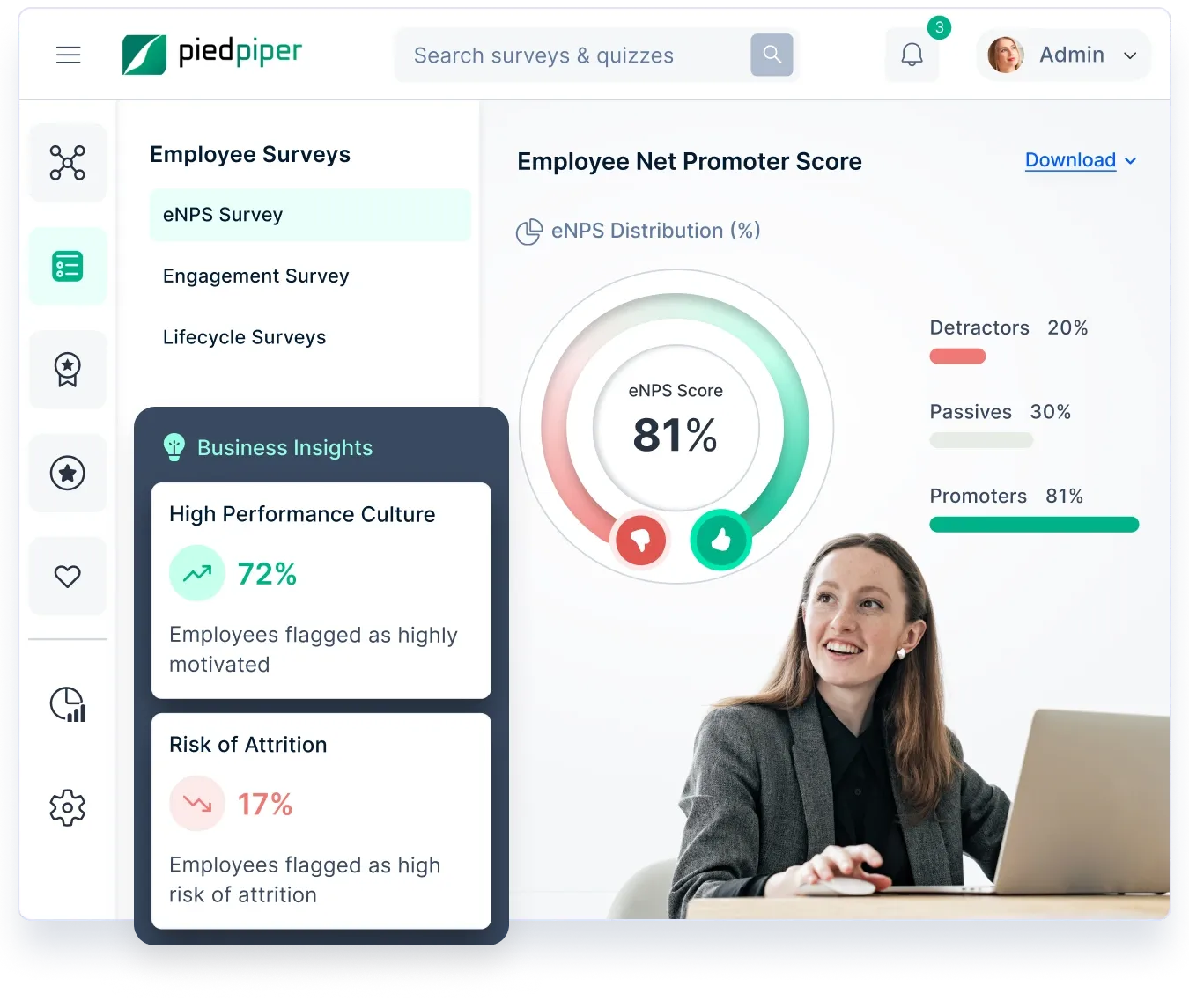
🔁 2. Lifecycle surveys for key moments
From onboarding and probation to promotions and exits, Empuls provides lifecycle-based surveys that are triggered at critical stages in an employee’s journey. These help capture feedback at the right time and uncover insights specific to each stage.
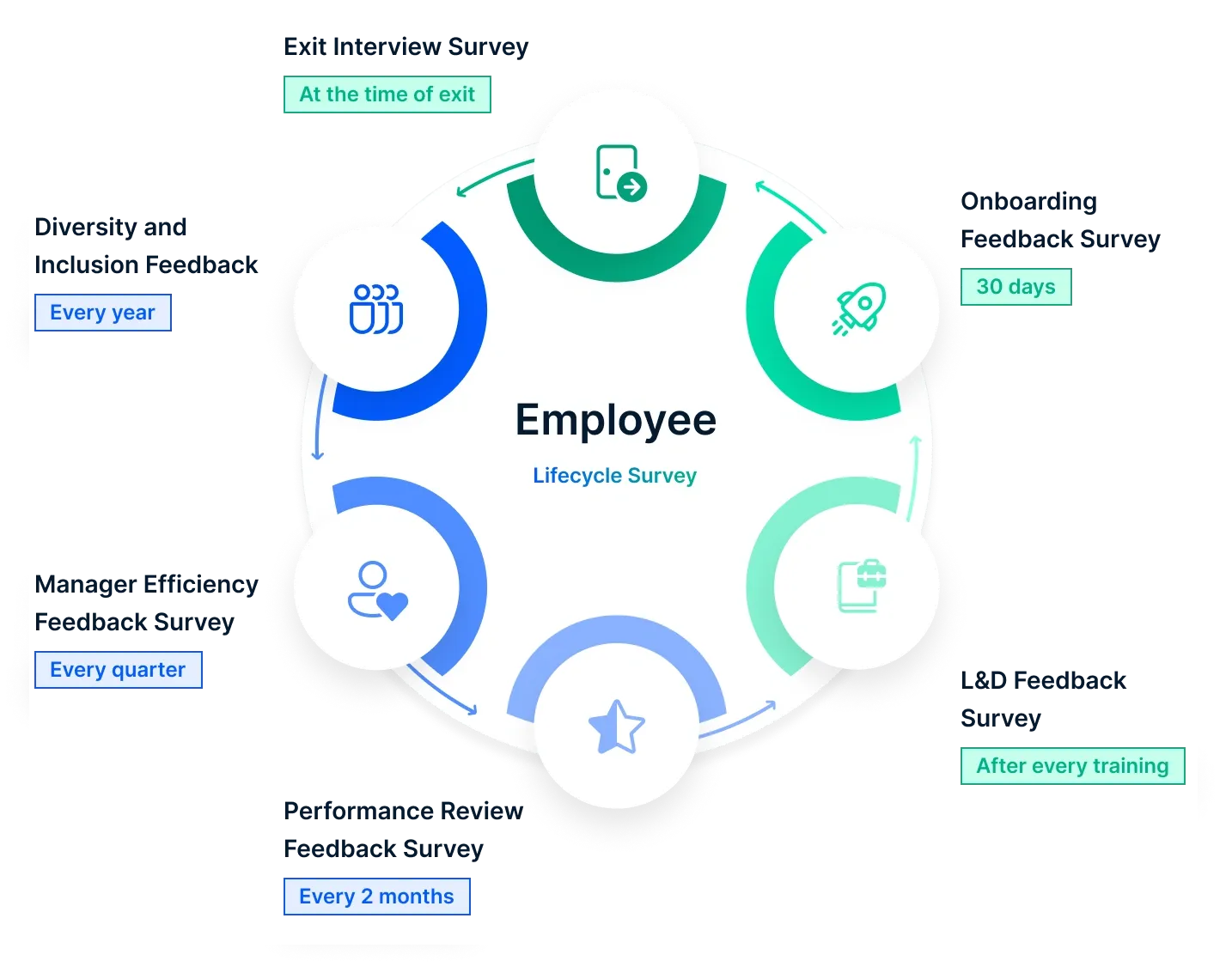
💡 3. AI-powered feedback insights
With Empuls’ AI-driven analytics, organizations get access to actionable insights and sentiment analysis. The platform identifies trends, pinpoints problem areas, and even suggests recommendations to boost engagement—all through a manager- and HR-friendly dashboard.
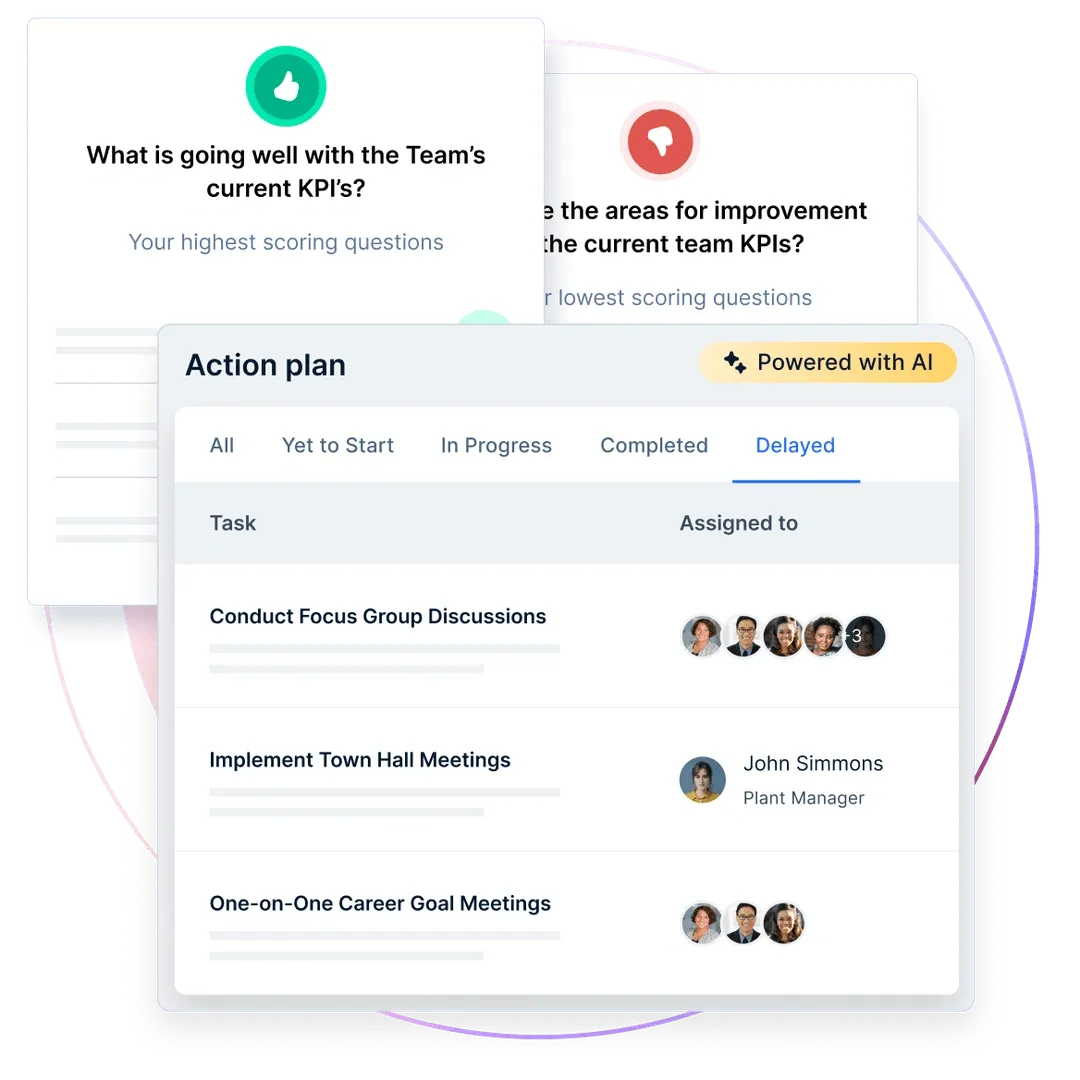
📈 4. Real-time people analytics
Empuls centralizes feedback, recognition, participation rates, and engagement scores into a single, real-time analytics dashboard. This allows leadership to slice and dice data by department, role, location, or team—and make data-backed decisions.
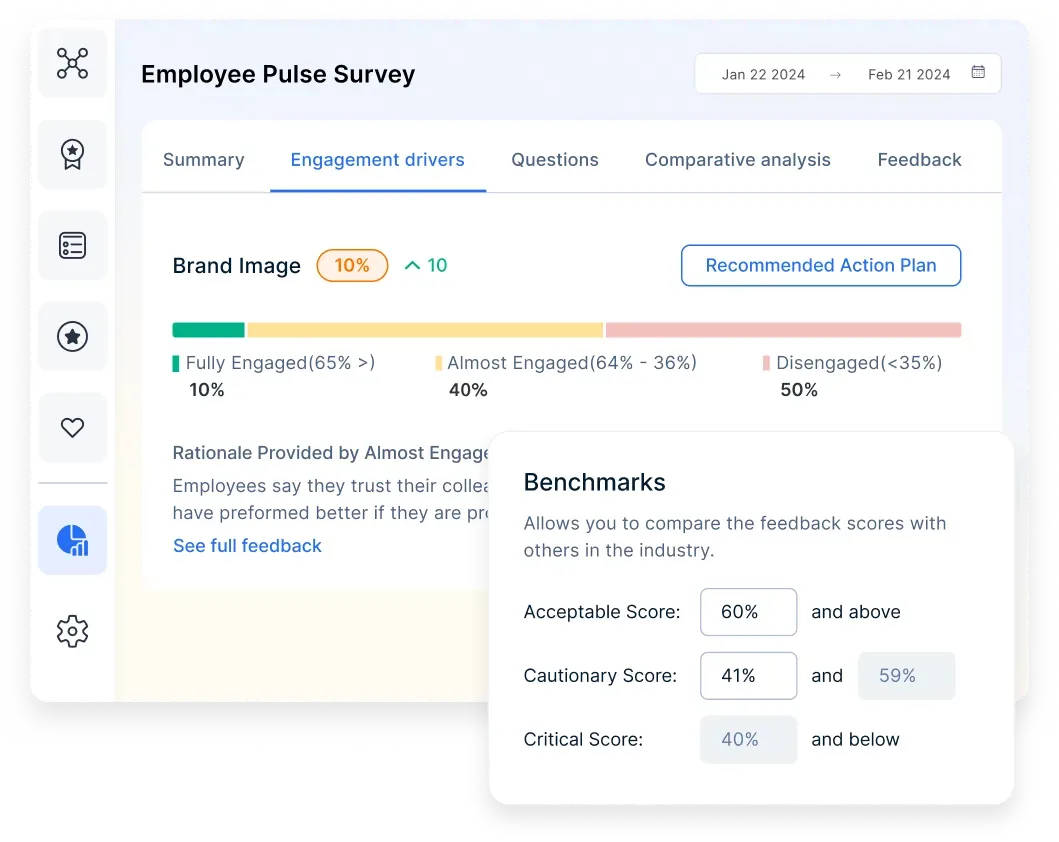
📣 5. Customizable question banks and templates
Not sure where to start? Empuls includes a rich library of expert-designed survey templates and question banks, making it easy to build surveys tailored to your organization's goals—whether you're focusing on DEI, leadership trust, communication, or rewards.
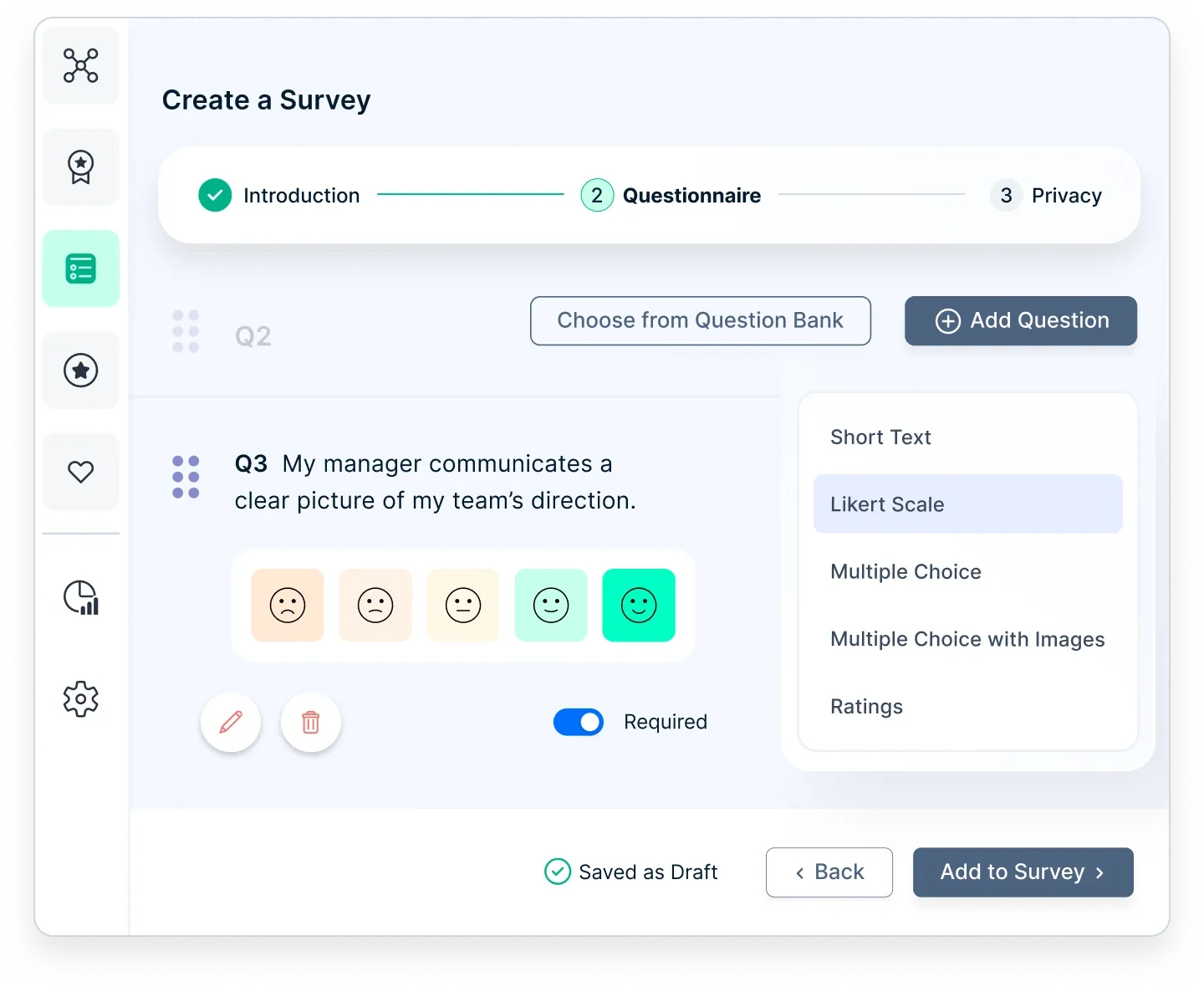
🧠 6. Nudges and reminders to increase participation
Low participation can be a major roadblock in engagement measurement. Empuls addresses this with smart nudges, reminders, and friendly prompts via email, Slack, MS Teams, and more—ensuring feedback is collected consistently and effortlessly.
By enabling continuous listening and providing 360° engagement intelligence, Empuls empowers HR leaders to measure what matters and act where it counts. It transforms feedback into action, turning your workplace into a more connected, inclusive, and motivated environment.
Bonus: Empuls integrates seamlessly with popular HRIS and communication tools, ensuring surveys and insights fit directly into the flow of work.
Conclusion
Engagement programs don’t succeed overnight—they’re built through consistent trial, refinement, and adaptation. What works for one business may fall flat in another. That’s why blindly applying a templated solution often leads to disappointment. Every organization needs to develop its own unique strategy based on real outcomes and feedback.
But how do you know what’s working? That’s where measurement becomes non-negotiable. Using the right employee engagement metrics, you can identify what drives impact and what needs to be phased out. It’s a simple truth: if you’re not tracking progress, you’re guessing.
Unfortunately, less than a third of employers worldwide track the ROI of employee engagement or use any structured approach for how to measure employee engagement. Without this, they’re left in the dark—unable to tell if their teams are truly engaged or if their efforts are falling short.


















